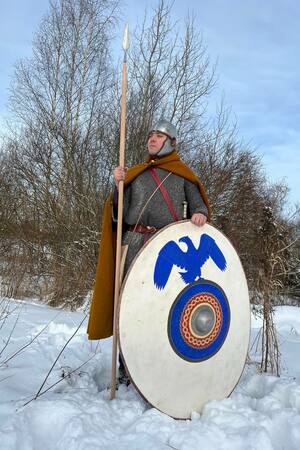Limitanei
Limitanei (Latin Limitanei, adj. Limitatenses) - soldiers of the units of the roman army during the Dominate, serving on the border.
Limitanei were located on border territories near or inside the border fortifications and forts of the limes. Soldiers of the river flotillas of the Rhine and Danube, rivers that served as natural boundaries of the state, were also called ripenses. Soldiers from the garrisons of large forts-castellums were also known as castellani, small outposts-burgs - burgarii. The task of the limitanei was, as in the times of the Principate, to guard the border. However, in the times of the Dominate, the defense of the empire's borders was built on the principle of defense in depth, and in case of a serious threat, the forces of the field army could be deployed from the depth of the province or diocese, whose limes was under threat.
The term limitanei is mentioned in the times of the Principate, however, it does not carry any other meaning except for the location of the military unit on the limes of the empire. In the period of the Dominate, as some scholars believe, the units of the Roman army were divided into limitanei, comitatenses, and palatine. Limitanei, as mentioned above, served on the limes, comitatenses can be conditionally attributed to the units of mobile field armies, capable of quickly coming to the aid of limitanei, suppressing rebellion within the empire and going on an offensive campaign to enemy territory, and palatine units served directly under the emperor and acted as his personal guard.
However, there is an example of Legio XIIII Comitatensis, who served on the border on the Danube as part of the ripenses, river infantry, flotilla, and coastal border forces. Ammianus Marcellinus, a Roman military leader and chronicler of the second half of the 4th century AD, mentions the term "comitat" exclusively in the meaning of troops, which are currently under the direct command of the emperor. Thus, a clear division of the Roman army of the Dominate times into stationary limitanei and mobile comitatenses may turn out to be a simplification, not fully reflecting reality.
Depending on the specifics of a particular section of the limes, limitanei could include in their composition infantry legions and auxilia, in the 4th century including both heavy line infantry and archers and slingers, alae and vexillations of cavalry, river vessels up to galleys, throwing weapons with their calculations, and so on.
Related topics
Late Roman Empire, Dominanus, Comitatensis, Soldiers of the Roman Empire of the Dominate era
Literature
1. Benjamin Knör. Das spätantike Offizierskorps (4./5. Jahrhundert), Verlag Grin, 2010,
2. Michael Whitby. Army and Society i.d. later Roman World, 2007, in: Averon Carneron/B.Ward Perkins/M.Whitby (Hrsg.) The Cambridge Ancient History Nr.14,
3. Badisches Landesmuseum Karlsruhe (Hrsgb.): Erben des Imperiums in Nordafrika. Das Königreich der Vandalen, darin: Yann Le Bohac: Africa in der späten Kaiserzeit, Die Provinz am Vorabend der vandalischen Eroberung, S. 65-78, Verlag P.v.Zabern, Karlsruhe 2009
4. Ammianus Marcellinus. Rerum Gestarum
5. A. V. Bannikov. Roman Army in the fourth century from Constantine to Theodosius



